|
1
|
Lever A and Mackenzie I: Sepsis:
Definition, epidemiology, and diagnosis. BMJ. 335:879–883. 2007.
View Article : Google Scholar : PubMed/NCBI
|
|
2
|
Zambon M, Ceola M, Almeida-de-Castro R,
Gullo A and Vincent JL: Implementation of the surviving sepsis
campaign guidelines for severe sepsis and septic shock: We could go
faster. J Crit Care. 23:455–460. 2008. View Article : Google Scholar : PubMed/NCBI
|
|
3
|
Pierrakos C and Vincent JL: Sepsis
biomarkers: A review. Crit Care. 14:R152010. View Article : Google Scholar : PubMed/NCBI
|
|
4
|
Levy MM, Fink MP, Marshall JC, Abraham E,
Angus D, Cook D, Cohen J, Opal SM, Vincent JL and Ramsay G;
SCCM/ESICM/ACCP/ATS/SIS, : 2001 SCCM/ESICM/ACCP/ATS/SIS
International Sepsis Definitions Conference. Crit Care Med.
31:1250–1256. 2003. View Article : Google Scholar : PubMed/NCBI
|
|
5
|
Knaus WA, Draper EA, Wagner DP and
Zimmerman JE: APACHE II: A severity of disease classification
system. Crit Care Med. 13:818–829. 1985. View Article : Google Scholar : PubMed/NCBI
|
|
6
|
Shapiro NI, Wolfe RE, Moore RB, Smith E,
Burdick E and Bates DW: Mortality in Emergency Department Sepsis
(MEDS) score: a prospectively derived and validated clinical
prediction rule. Crit Care Med. 31:670–675. 2003. View Article : Google Scholar : PubMed/NCBI
|
|
7
|
Vincent JL, Moreno R, Takala J, Willatts
S, De Mendonça A, Bruining H, Reinhart CK, Suter PM and Thijs LG:
The SOFA (Sepsis-related Organ Failure Assessment) score to
describe organ dysfunction/failure. On behalf of the working group
on sepsis-related problems of the European Society of Intensive
Care Medicine. Intensive Care Med. 22:707–710. 1996. View Article : Google Scholar : PubMed/NCBI
|
|
8
|
Shirakawa K, Naitou K, Hirose J, Takahashi
T and Furusako S: Presepsin (sCD14-ST): Development and evaluation
of one-step ELISA with a new standard that is similar to the form
of presepsin in septic patients. Clin Chem Lab Med. 49:937–939.
2011. View Article : Google Scholar : PubMed/NCBI
|
|
9
|
Alberti C, Brun-Buisson C, Burchardi H,
Martin C, Goodman S, Artigas A, Sicignano A, Palazzo M, Moreno R,
Boulmé R, et al: Epidemiology of sepsis and infection in ICU
patients from an international multicentre cohort study. Intensive
Care Med. 28:108–121. 2002. View Article : Google Scholar : PubMed/NCBI
|
|
10
|
Vincent JL, Sakr Y, Sprung CL, Ranieri VM,
Reinhart K, Gerlach H, Moreno R, Carlet J, Le Gall JR and Payen D;
Sepsis occurrence in acutely Ill patients investigators, : Sepsis
in European intensive care units: Results of the SOAP study. Crit
Care Med. 34:344–353. 2006. View Article : Google Scholar : PubMed/NCBI
|
|
11
|
Esteban A, Frutos-Vivar F, Ferguson ND,
Peñuelas O, Lorente JA, Gordo F, Honrubia T, Algora A, Bustos A,
García G, et al: Sepsis incidence and outcome: Contrasting the
intensive care unit with the hospital ward. Crit Care Med.
35:1284–1289. 2007. View Article : Google Scholar : PubMed/NCBI
|
|
12
|
Gonsalves MD and Sakr Y: Early
identification of sepsis. Curr Infect Dis Rep. 12:329–335. 2010.
View Article : Google Scholar : PubMed/NCBI
|
|
13
|
Bauer M and Reinhart K: Molecular
diagnostics of sepsis - where are we today? Int J Med Microbiol.
300:411–413. 2010. View Article : Google Scholar : PubMed/NCBI
|
|
14
|
Levy MM: Preface biomarkers in critical
illness. Crit Care Clin. 27:xiii–xv. 2011. View Article : Google Scholar : PubMed/NCBI
|
|
15
|
Bongers TN, de Maat MP, van Goor ML,
Bhagwanbali V, van Vliet HH, Gómez García EB, Dippel DW and Leebeek
FW: High von Willebrand factor levels increase the risk of first
ischemic stroke: Influence of ADAMTS13, inflammation, and genetic
variability. Stroke. 37:2672–2677. 2006. View Article : Google Scholar : PubMed/NCBI
|
|
16
|
Nguyen TC, Liu A, Liu L, Ball C, Choi H,
May WS, Aboulfatova K, Bergeron AL and Dong JF: Acquired ADAMTS-13
deficiency in pediatric patients with severe sepsis. Haematologica.
92:121–124. 2007. View Article : Google Scholar : PubMed/NCBI
|
|
17
|
Claus RA, Bockmeyer CL, Budde U, Kentouche
K, Sossdorf M, Hilberg T, Schneppenheim R, Reinhart K, Bauer M,
Brunkhorst FM, et al: Variations in the ratio between von
Willebrand factor and its cleaving protease during systemic
inflammation and association with severity and prognosis of organ
failure. Thromb Haemost. 101:239–247. 2009. View Article : Google Scholar : PubMed/NCBI
|
|
18
|
Scherpereel A, Depontieu F, Grigoriu B,
Cavestri B, Tsicopoulos A, Gentina T, Jourdain M, Pugin J, Tonnel
AB and Lassalle P: Endocan, a new endothelial marker in human
sepsis. Crit Care Med. 34:532–537. 2006. View Article : Google Scholar : PubMed/NCBI
|
|
19
|
Chng WJ, Yip CY, Baliwag MB and Liu TC:
Differential effect of the ABO blood group on von Willebrand factor
collagen binding activity and ristocetin cofactor assay. Blood
Coagul Fibrinolysis. 16:75–78. 2005. View Article : Google Scholar : PubMed/NCBI
|
|
20
|
Sadler JE: Biochemistry and genetics of
von Willebrand factor. Annu Rev Biochem. 67:395–424. 1998.
View Article : Google Scholar : PubMed/NCBI
|
|
21
|
van Mourik JA, Boertjes R, Huisveld IA,
Fijnvandraat K, Pajkrt D, van Genderen PJ and Fijnheer R: von
Willebrand factor propeptide in vascular disorders: a tool to
distinguish between acute and chronic endothelial cell
perturbation. Blood. 94:179–185. 1999.PubMed/NCBI
|
|
22
|
Lerolle N, Dunois-Lardé C, Badirou I,
Motto DG, Hill G, Bruneval P, Diehl JL, Denis CV and Baruch D: von
Willebrand factor is a major determinant of ADAMTS-13 decrease
during mouse sepsis induced by cecum ligation and puncture. J
Thromb Haemost. 7:843–850. 2009. View Article : Google Scholar : PubMed/NCBI
|
|
23
|
Dong JF, Moake JL, Nolasco L, Bernardo A,
Arceneaux W, Shrimpton CN, Schade AJ, McIntire LV, Fujikawa K and
López JA: ADAMTS-13 rapidly cleaves newly secreted ultralarge von
Willebrand factor multimers on the endothelial surface under
flowing conditions. Blood. 100:4033–4039. 2002. View Article : Google Scholar : PubMed/NCBI
|
|
24
|
Ley K, Laudanna C, Cybulsky MI and
Nourshargh S: Getting to the site of inflammation: The leukocyte
adhesion cascade updated. Nat Rev Immunol. 7:678–689. 2007.
View Article : Google Scholar : PubMed/NCBI
|
|
25
|
Reiter RA, Varadi K, Turecek PL, Jilma B
and Knöbl P: Changes in ADAMTS13 (von-Willebrand-factor-cleaving
protease) activity after induced release of von Willebrand factor
during acute systemic inflammation. Thromb Haemost. 93:554–558.
2005. View Article : Google Scholar : PubMed/NCBI
|
|
26
|
Martin K, Borgel D, Lerolle N, Feys HB,
Trinquart L, Vanhoorelbeke K, Deckmyn H, Legendre P, Diehl JL and
Baruch D: Decreased ADAMTS-13 (A disintegrin-like and
metalloprotease with thrombospondin type 1 repeats) is associated
with a poor prognosis in sepsis-induced organ failure. Crit Care
Med. 35:2375–2382. 2007. View Article : Google Scholar : PubMed/NCBI
|
|
27
|
Cao WJ, Niiya M, Zheng XW, Shang DZ and
Zheng XL: Inflammatory cytokines inhibit ADAMTS13 synthesis in
hepatic stellate cells and endothelial cells. J Thromb Haemost.
6:1233–1235. 2008. View Article : Google Scholar : PubMed/NCBI
|
|
28
|
Ono T, Mimuro J, Madoiwa S, Soejima K,
Kashiwakura Y, Ishiwata A, Takano K, Ohmori T and Sakata Y: Severe
secondary deficiency of von Willebrand factor-cleaving protease
(ADAMTS13) in patients with sepsis-induced disseminated
intravascular coagulation: Its correlation with development of
renal failure. Blood. 107:528–534. 2006. View Article : Google Scholar : PubMed/NCBI
|
|
29
|
Biron BM, Ayala A and Lomas-Neira JL:
Biomarkers for sepsis: What is and what might be? Biomark Insights.
10 (Suppl 4):7–17. 2015.PubMed/NCBI
|
|
30
|
Pepys MB and Hirschfield GM: C-reactive
protein: A critical update. J Clin Invest. 111:1805–1812. 2003.
View Article : Google Scholar : PubMed/NCBI
|
|
31
|
Maruna P, Nedelníková K and Gürlich R:
Physiology and genetics of procalcitonin. Physiol Res. 49 (Suppl
1):S57–S61. 2000.PubMed/NCBI
|
|
32
|
Becker KL, Snider R and Nylen ES:
Procalcitonin assay in systemic inflammation, infection, and
sepsis: Clinical utility and limitations. Crit Care Med.
36:941–952. 2008. View Article : Google Scholar : PubMed/NCBI
|
|
33
|
Billeter A, Turina M, Seifert B, Mica L,
Stocker R and Keel M: Early serum procalcitonin, interleukin-6, and
24-hour lactate clearance: useful indicators of septic infections
in severely traumatized patients. World J Surg. 33:558–566. 2009.
View Article : Google Scholar : PubMed/NCBI
|
|
34
|
Brunkhorst FM, Al-Nawas B, Krummenauer F,
Forycki ZF and Shah PM: Procalcitonin, C-reactive protein and
APACHE II score for risk evaluation in patients with severe
pneumonia. Clin Microbiol Infect. 8:93–100. 2002. View Article : Google Scholar : PubMed/NCBI
|
|
35
|
Bele N, Darmon M, Coquet I, Feugeas JP,
Legriel S, Adaoui N, Schlemmer B and Azoulay E: Diagnostic accuracy
of procalcitonin in critically ill immunocompromised patients. BMC
Infect Dis. 11:2242011. View Article : Google Scholar : PubMed/NCBI
|











